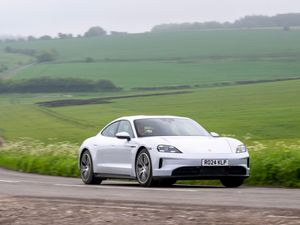Mazda MX-30 range-extender revealed with rotary engine
Plug-in hybrid model will sit alongside existing EV.

Mazda has revealed a plug-in hybrid version of its electric MX-30 crossover, powered in part by a new rotary petrol engine.
Unveiled at the Brussels Motor Show, the MX-30 R-EV takes elements of Mazda’s existing battery-powered electric car and adds a petrol-powered motor, extending the possible driving distance between visits to a charge point.
The newly-developed 74bhp rotary engine – similar in design to those used in famous Mazda sports cars like the RX-7 and RX-8 – has been slotted under the bonnet, alongside a 164bhp electric motor.
Unlike most petrol/electric plug-in hybrids however, the MX-30’s petrol engine never directly powers the wheels. Instead, it helps top up a 17.8kWh battery, which is then used to power the MX-30 R-EV’s electric motor.

The result, says Mazda, is smooth and effortless performance, without the awkward interruption in power delivery that can be noticeable in some plug-in hybrid cars.
Mazda no doubt hopes that the R-EV goes some way to addressing the criticism of the regular MX-30 EV: notably its comparatively small range. While the fully-electric MX-30 offers a claimed 124 miles of range, Mazda suggests the R-EV should be able to cover ‘more than 400 miles’ before needing a top-up of petrol.
However, in order to squeeze in the necessary petrol-related elements like a 50-litre fuel tank, Mazda has halved the size of the battery – meaning the MX-30 R-EV can only travel a claimed 53 miles on electricity alone.
That may not sound like a lot, but it does put the MX-30 ahead of similarly priced rivals: a Renault Captur PHEV can only manage around 30 miles of electric-only range, for example.
The MX-30 R-EV should prove to be a touch more refined to drive than its rivals, too. Rotary engines tend to be much smoother, quieter and more free-revving than the regular piston engines of most cars, which all helps in an otherwise silent electric vehicle.
Mazda also claims no drop-off in performance once the battery charge has dropped: the MX-30’s top speed of a modest 87mph is achievable whichever way the car is being powered.
The addition of a petrol engine shouldn’t change the MX-30’s driving dynamics too much either: kerb weight is within a few dozen kilos of the fully-electric model, while its 0-60mph figure has actually improved by half a second.
Describing the MX-30 R-EV, Mazda UK managing director Jeremy Thomson said: “it’s a car that’s the perfect solution for customers who want an electric car for everyday usage but the flexibility to undertake longer journeys without the reliance on charging infrastructure.

“With the option to choose either the pure electric MX-30 or the new R-EV version depending on their needs, our customers now have even more choice.”
The MX-30 R-EV is priced identically to the regular MX-30 EV – with ‘Prime-Line’ entry-level models starting at £31,250 on the road, and top-end ‘Makoto’ trim starting at £35,550.
An ‘Edition-R’ trim level, featuring a unique black and maroon colour scheme and rotary-inspired detailing, is available exclusively on the R-EV and is priced from £37,950.
The MX-30 R-EV is available to order immediately, with cars due to arrive in showrooms later this year.





